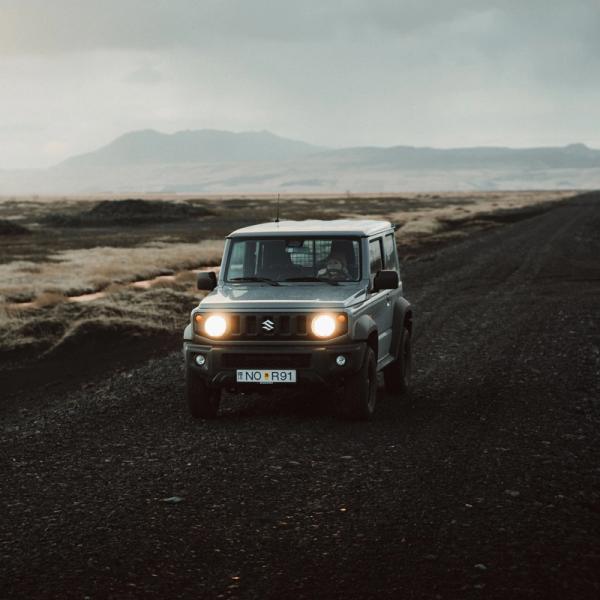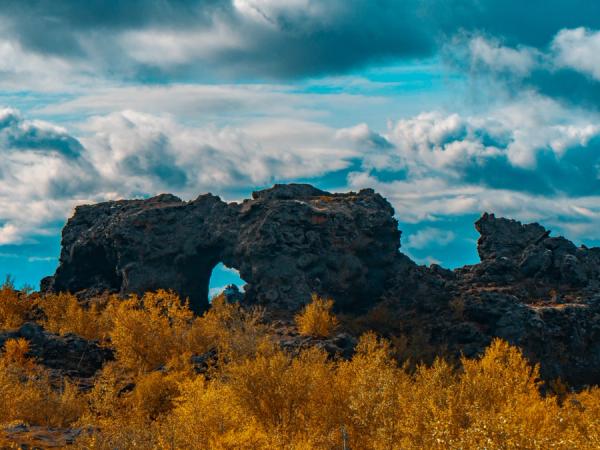
Dimmuborgir, the dark lava castles of the north
Imagine driving through North Iceland and, suddenly, you start to see an imposing castle in the distance. As it’s natural, you feel curious and try to get closer to see it. Then, there’s another, similar but different, not far from it. And another. And another. But they are not castles nor fortresses. There’s nothing made by the human hand here. They are some of the strangest and unique rock formations you’ve ever seen. And, to be fair, they kind of look like castles.
Welcome to Dimmuborgir, one of the most astonishing volcanic landscapes in all of Iceland. Here, lava formations twist into towers, arches, and caves. Its appearance is so different that this area has also inspired countless tales and legends of trolls, elves, and hidden people. And, on top of that, it’s located close to some of the best things to see in the country. Come with us to discover this amazing corner of Iceland.
Key Takeaways
- Dimmuborgir is a huge volcanic landscape with unique formations.
- Its name translates as “Dark Castles”, as it’s what it seems from a distance.
- It’s very close to the Diamond Circle, a fantastic scenic route through North Iceland.
What’s Dimmuborgir?
Dimmuborgir is a mesmerizing lava field just east of Lake Mývatn, one of the main attractions in North Iceland. Both places were formed at the same time, as a result of a catastrophic volcanic event that took place 2,300 years ago. Back then, a series of eruptions sent lava flowing into a small lake, causing the water to boil and send steam up through the cooling lava. This dramatic interaction formed a labyrinth of towering basalt pillars, hollowed caves, and natural arches, some reaching 20 meters (66 feet) high, while others are delicate spires barely taller than a person.
In Icelandic, Dimmuborgir means "Dark Castles," and there’s a reason why. From some distance, these strange formations can resemble fortresses or castles, and the color of basalt is close to black. Here, the landscape feels alive yet frozen in time, with the dark jagged rocks contrasting against patches of vibrant green moss or, in winter, blankets of snow.
Some of the shapes created by the lava stand out. One of them is Kirkjan, also known as "The Church," a lava formation featuring a soaring, arched ceiling that resembles a Gothic cathedral. You can even get inside its cave, where the structure creates an echo. Other formations have sparked the imaginations of the locals for centuries. Some have seen trolls, elves, or other mythical creatures in the twisted rocks. In Iceland, many natural places are linked to legends and tales. The unique look of some of them served as inspiration for the creation of mythological stories. For example, it is said that Dimmuborgir is the home of the Yule Lads, Iceland’s mischievous Christmas spirits, and their fearsome parents, Grýla and Leppalúði.
Apart from the folklore, Dimmuborgir has been seen in the world-famous TV series Game of Thrones. The unique and outstanding landscapes of this Nordic country have appeared many times in this acclaimed show, and Dimmuborgir is one of them. It was the setting chosen for the rugged wildling camp beyond the Wall.
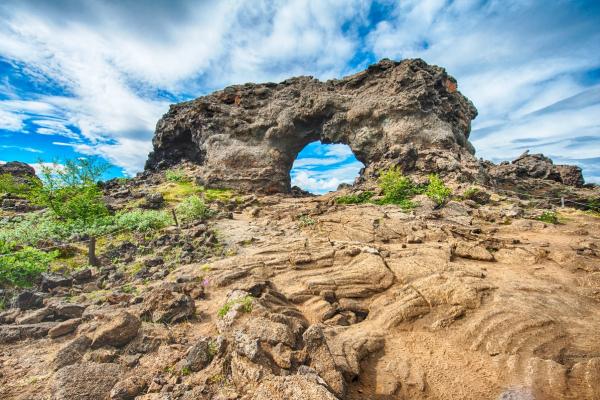
Why is Dimmuborgir Worth a Visit?
North Iceland is a region full of wonderful things to see. It’s, perhaps, not as famous and visited as other parts of the country, and many tourists miss some of the most incredible monuments on the island. It’s quite easy to create an itinerary through this region and see a lot, and Dimmuborgir is one of the must-see places in this area.
Its allure lies in its unique blend of geological wonder, cultural richness, and natural beauty. The lava fields are quite rare and unique, created by a process more commonly seen in underwater volcanic environments, like Mexico’s coastal lava tubes. Here, the interaction of lava and water crafted a maze of pillars, arches, and caves that feel like a natural sculpture garden.
There are several trails that allow you to explore everything. One of them is the easy “Small Circle” (1 km/0.6 miles). If you prefer something more challenging and complete, you can opt for the “Big Circle” (3.4 km/2.1 miles). Either way, both let you immerse yourself in this surreal terrain, where every turn reveals a new formation—some resembling mythical creatures, others simply natural sculptures that look like anything else.
Also, photographers will find endless inspiration in the interplay of light and shadow, especially at sunrise or sunset when the low sun creates even more fascinating silhouettes.
It’s also a great location for bird watching. Many species, such as gyrfalcons or redwings, choose Dimmuborgir as a nesting place. The intricate system of formations creates great protected places for these birds to lay their eggs. Visitors are advised to stay on marked paths to protect the fragile habitats of these animals.
The best way to discover every corner is on foot. You can wander on your own or you can book a spot on a guided tour. The trails are well-maintained, with wooden boardwalks in some areas to protect the delicate lava structures. In winter, the snow-covered landscape transforms Dimmuborgir, and the contrast between the solidified lava and the snow is amazing.
There’s no entry fee, and its proximity to other attractions, such as Lake Mývatn, makes it an accessible highlight for any itinerary.
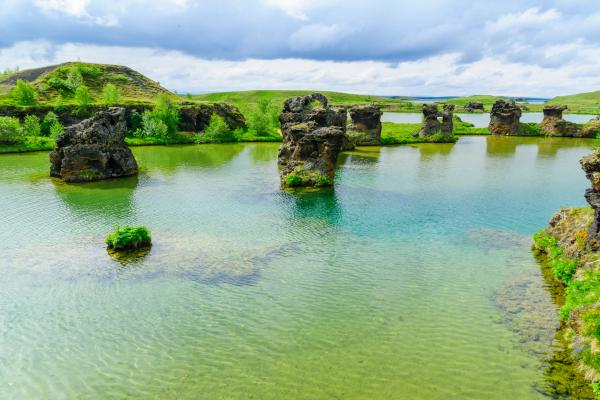
Where’s Dimmuborgir and How to Get There
As we mentioned earlier, Dimmuborgir lies in North Iceland, just east of Lake Mývatn. It’s 471 km (293 miles) away from Reykjavík and 82 km (51 miles) from Akureyri, the main city in this part of the country. From Reykjavík, it takes around 6 hours to get there without stops, but the itinerary is quite easy to follow.
Start by taking the Ring Road (Route 1) north. After reaching Akureyri, continue on Route 1 for another hour. Once you’ve reached the town of Reykjahlíð, take Route 848. About 5 km (3 miles) later, a clearly marked left turn leads to Dimmuborgir’s parking lot, 1.5 km (0.9 miles) down a paved road. From Akureyri, the drive takes about an hour via Route 1 and the same Route 848 turnoff.
The parking area is free, spacious, and just a short walk (less than 100 meters) from the beginning of the main trail, where an orientation table provides a map of the trails. A standard car is enough for the paved roads in summer, but a 4x4 vehicle is recommended for winter or if you plan to explore beyond the main routes.
There’s a small café in the parking area, serving hot beverages and snacks. There are also restrooms. The trails are clearly marked, with options for all fitness levels.
The Weather at Dimmuborgir
North Iceland, like the rest of the country, is a region where the weather changes constantly and is unpredictable. In spite of its variability, here’s what you can expect in each season.
Spring (April and May)
After the long winter, springs come with temperatures on the rise, between 5°C and 10°C (41°F to 50°F). The lava fields come alive with blooming flowers, adding splashes of green and yellow to the dark rocks. There could still be lingering snow in some areas. The days grow longer week after week, with 16 hours of natural light by the end of May. It’s common to have rain and wind, so dress with waterproof clothes to stay comfortable.
Summer (June to August)
Summer is the warmest and most stable season, with mild temperatures of 10°C to 15°C (50°F to 59°F) and nearly 24 hours of daylight by the summer solstice. It’s normal to have sunny spells mixed with some light showers. It’s the best time for photography and hiking, though expect more visitors, especially in July. Early mornings or late evenings are usually quieter and offer the best light atmosphere for pictures.
Autumn (September and October)
Very similar to spring, but going in the opposite direction. The temperatures drop, averaging between 5°C and 10°C (41°F and 50°F), and the days grow shorter. The plants get beautiful colors, with golds, browns, and reds painting the landscapes. Rain and wind are more frequent, so layered clothing and windproof gear are essential. The first days of snow can come by mid-October.
Winter (November to March)
Dimmuborgir looks especially magical under the snow, but the conditions for travelling can be complicated. The temperature rarely goes above 0°C (32°F) and the average minimum is around -5°C (23°F). Snow and ice can make driving tricky, and some roads close for the season, especially secondary roads and F-Roads. There’s not much daylight, barely 4 to 6 hours. On the other hand, this is the best season to see the Northern Lights.
What to Wear at Dimmuborgir
Packing smart for your visit can be a dealbreaker. Here's what you should bring.
- Waterproof Jacket and Pants: Rain and wind are common companions, so these are your best allies to stay dry.
- Dress in Layers: As the temperatures shift so dramatically, the best way to adapt to these changes is dressing in layers. Moisture-wicking base layer; wool or fleece for intermediate; and finishing with a waterproof jacket.
- Sturdy Hiking Boots: Waterproof ones with grip are necessary to deal with the rocky trails and the uneven lava fields.
- Hat, Gloves, and Scarf: Essential for shielding against wind and cold, especially in autumn and winter.
- Sunglasses and Sunscreen: Even if it’s not hot, the sun can be surprisingly hot in Iceland, especially in Summer. In winter, the reflection on the snow can harm your eyes and skin.

What to See and Do Near Dimmuborgir
Dimmuborgir is a fantastic destination by itself. But, luckily, it’s also quite close to some amazing places. Although it’s not officially considered part of it, it’s just by the Diamond Circle, a scenic route showcasing North Iceland’s finest landscapes. From impressive waterfalls to soothing geothermal baths, these attractions are the perfect complement to a day a visit to Dimmuborgir. Bear in mind that to see all of them, you’ll need two or three days. Below are some highlights to include in your itinerary:
Lake Mývatn
This beautiful lake was formed at the same time as Dimmuborgir as a result of the same volcanic event. And they are just a few hundred meters away. In Lake Mývatn, you’ll find pseudo craters, created when lava flowed over wetlands, that rise over the water, which is of beautiful tones of green and blue. The shores and wetlands around the lake are one of the best places for birdwatching in Iceland. Summer is the best time to see them, with arctic terns, common snipes, and tufted ducks as common sights.

Mývatn Nature Baths
No visit to Iceland is complete without a geothermal bath. And, luckily, one of the best places in the country is just next door from Dimmuborgir. Here you can relax in warm milky-blue waters, rich in minerals. Mývatn Nature Baths is a geothermal spa that gives the chance to connect with this part of Icelandic culture while enjoying awesome views. Arrive early to avoid crowds, and book ahead in summer for a seamless experience.

Hverfjall Crater
This massive volcanic cone, one of Iceland’s largest, offers a striking glimpse into the region’s volcanic history. A short hike to the crater’s rim rewards you with sweeping views of Lake Mývatn and Dimmuborgir’s lava fields.
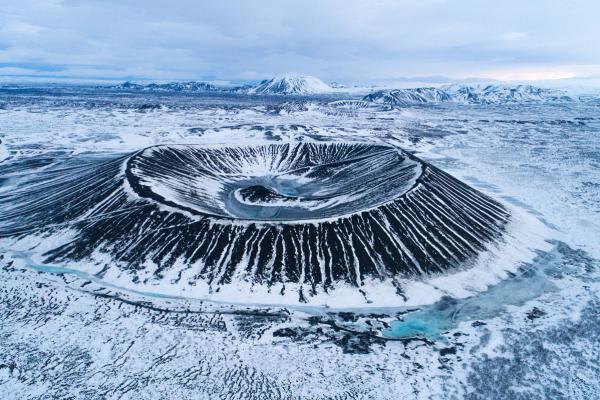
Grjótagjá Cave
This small lava cave houses a steaming geothermal pool. The color of the water is astonishing, of an intense turquoise, glowing against the dark rock walls. The water is too hot for bathing, though. This place gained international fame when it appeared in Game of Thornes, being the setting of a romantic scene between Ygritte and Jon Snow. Yes, you know which one I’m talking about.
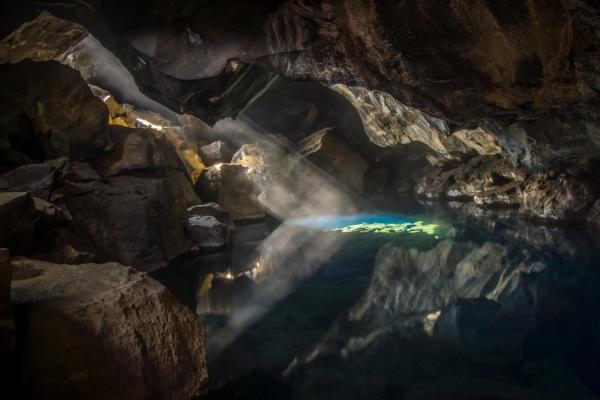
Dettifoss Waterfall
Iceland is full of fantastic waterfalls, and Dettifoss is the most powerful of them all. “The Beast”, as nicknamed by the locals, is 44 meters (144 feet) high and 100 meters (328 feet) wide, dropping into a canyon. The roar produced by the waterfall can be heard from quite some distance. You can view it from both the east and west sides of the river, each offering unique perspectives and experiences.
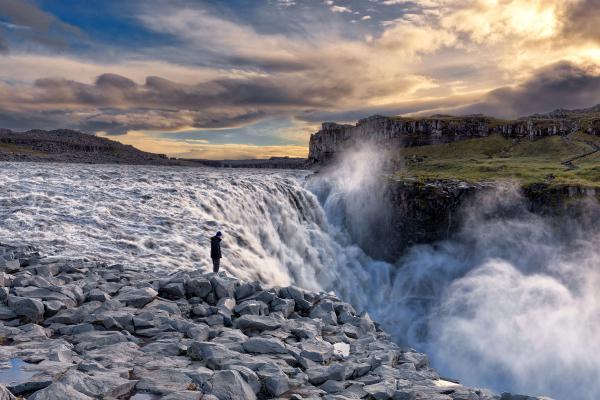
Ásbyrgi Canyon
Ásbyrgi is a horseshoe-shaped canyon and one of the most striking natural locations in North Iceland. It was created thousands of years ago by glacial floods, but the legend says otherwise. According to Norse mythology, Ásbyrgi was created when Sleipnir, Odin’s eight-legged horse, struck the land here with its hoof. The rock walls reach up to 100 meters tall (328 feet) and there’s a birch forest and a little lake at the bottom. There are several trails to get to the different parts of the canyon.
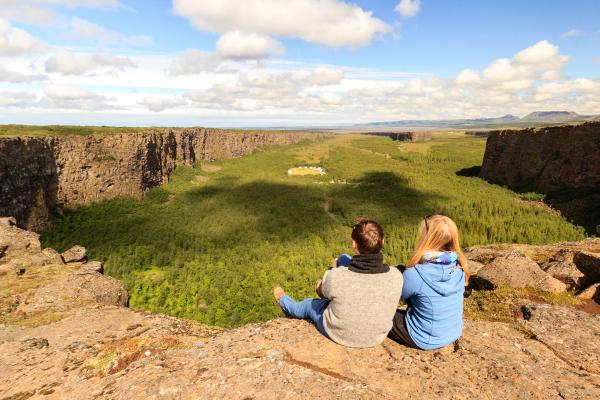
Húsavík
Húsavík, commonly referred to as Iceland’s whale-watching capital, offers boat tours to see orcas, humpback whales, minke whales, and, if you’re lucky enough, blue whales. The tours depart from the town’s harbor and explore the beautiful Skjálfandi Bay. Húsavík also hosts the Whale Museum and has several cafés and restaurants where you can enjoy some authentic Icelandic food.
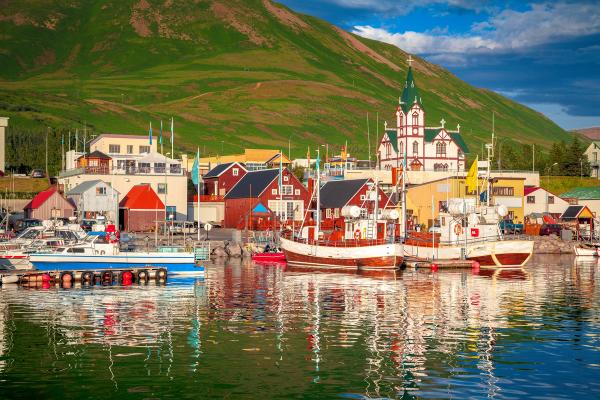
Goðafoss Waterfall
Another waterfall that is part of the Diamond Circle, but very different to the huge Dettifoss. Goðafoss, which means “Waterfall of the Gods,” is impressive but not in size. Its crescent shape and the color of the water are what impress visitors so much. The place also has an important historical significance, as it was here where, in the year 1000, lawspeaker and local chieftain Þorgeir Ljósvetningagoði threw his pagan idols into the water when the nation converted to Christianity.
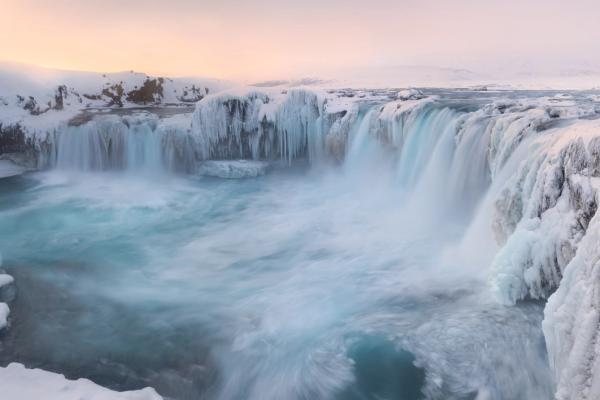
Where to Stay Near Dimmuborgir
You have several options in case you want to sleep near Dimmuborgir to visit very early (before the crowds arrive) or late (after the crowds have left).
- Dimmuborgir Guesthouse: Situated very close to the lava field and on the shore of Lake Mývatn, this modern guesthouse, with a rustic style, offers cozy rooms with access to a shared kitchen or private cabins featuring their own kitchens. They also offer breakfast.
- Vogafjós Farm Resort: This charming resort features cottages, apartments, and hotel rooms with Lake Mývatn views. Its farm-to-table restaurant serves fresh, local dishes. It has been run by the same family for 120 years.
- Hotel Laxá: A stylish option with comfortable rooms and lake views, this hotel is ideal for those seeking modern amenities and easy access to nearby attractions. It has a well rated restaurant, called Eldey.
- Eldá Guesthouse: Located in Reykjahlíð, this cozy guesthouse offers a warm, homey atmosphere at a reasonable price.
Travel Tips
- Book Accommodations Early: The Mývatn area fills up quickly in summer, so secure your stay months in advance.
- Monitor the Aurora Forecast: This area is fantastic to see the Northern Lights in winter, but the night needs to be clear. Check the forecast to maximize your options.
- Stay on Marked Trails: Dimmuborgir is an impressive but fragile ecosystem. Don’t wander off marked trails to protect the lava formations, the moss, and the birds’ nesting areas.
- Bring a Camera: The lava field’s unique shapes and different beauty are a photographer’s dream, especially at dawn or dusk.
- Combine Attractions: Pair Dimmuborgir with Mývatn Nature Baths or Hverfjall for a full day of exploration.
- Choose the Right Vehicle: While most of the roads in the area are paved and a standard vehicle may be enough, rent a 4x4 car if you’re coming in winter or plan to venture to more remote areas.
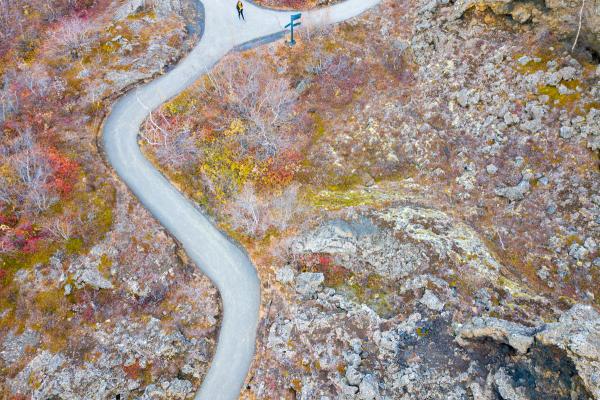
Conclusion
Dimmuborgir is a portal to Iceland’s volcanic heart, where twisted lava formations and ancient legends create a landscape that feels both timeless and magical. Here, you’ll see yourself surrounded by rock formations like no others you’ve seen before. Getting lost in this maze of natural spires and towers is a once-in-a-lifetime experience. Also, it’s very close to some of the best things to see in North Iceland. Pack your bags, rent a car, and get in touch with Iceland’s wildest side.

